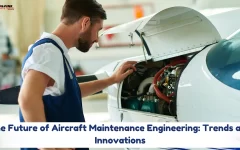AME B1.1 Certification: Major Aircrafts, Engines, and Its Crucial Role in India’s Aviation Industry
2024-12-23 7:39AME B1.1 Certification: Major Aircrafts, Engines, and Its Crucial Role in India’s Aviation Industry

AME B1.1 Certification: Major Aircrafts, Engines, and Its Crucial Role in India’s Aviation Industry
India’s aviation industry has seen explosive growth over the past few years, becoming one of the fastest-growing markets for air travel globally. With an increasing fleet size, a rising number of airlines, and expanding regional connectivity, the demand for skilled professionals in aircraft maintenance has never been higher. Among these professionals, AME B1.1 certified engineers are in high demand. Their expertise in maintaining mechanical systems including airframes, engines, and landing gear, ensures the safety, reliability, and efficiency of both commercial and military aircraft.
What is AME B1.1 Certification?
AME (Aircraft Maintenance Engineer) B1.1 certification is an essential qualification for engineers specializing in the maintenance of mechanical systems in aircraft. B1.1 engineers are responsible for ensuring that the airframe, engine, and other mechanical systems such as hydraulics, landing gear, and auxiliary power units (APUs) are maintained to meet safety standards set by aviation regulators.
In India, the DGCA (Directorate General of Civil Aviation) oversees the certification and training of AMEs. The B1.1 category specifically focuses on mechanical maintenance, while other categories (like B2 for avionics) deal with electronic systems.
Key Responsibilities of AME B1.1 Engineers:
- Conducting inspections on aircraft systems and components.
- Performing routine maintenance and troubleshooting mechanical issues.
- Managing overhaul procedures for engines and airframes.
- Ensuring compliance with safety and regulatory standards.
The AME B1.1 certification is vital in ensuring that engineers possess the knowledge and skills to work on complex aircraft systems, which is crucial for India’s rapidly growing aviation market.
Major Aircrafts in India: A Broad Overview
India’s aviation sector is home to a variety of aircraft that are used by both commercial airlines and the military. Each of these aircraft requires specialized maintenance by AME B1.1 engineers, who focus on keeping airframes, engines, and other mechanical components in optimal condition.
1. Boeing 737: India’s Favorite Workhorse
The Boeing 737 is arguably the most widely used aircraft in India, operated by both low-cost carriers and full-service airlines. Airlines like IndiGo, SpiceJet, and Air India rely heavily on the 737 for domestic and international flights.
- Role of AME B1.1 Engineers: Engineers focus on maintaining the turbofan engines and airframe of the 737, performing tasks such as engine performance checks, landing gear inspections, and airframe structural assessments.
- Key Maintenance Tasks:
- CFM56 Engine Checks: Regular inspections of the CFM56 engine, which is one of the most widely used engines in commercial aviation, including checking for wear and tear on turbine blades and other critical components.
- Landing Gear Inspections: Ensuring the landing gear system is functional and free from damage, ensuring safe landings and takeoffs.
- Airframe Maintenance: This includes checking the fuselage, wings, and tail structure for signs of fatigue, cracks, or corrosion.
2. Airbus A320: The European Giant
The Airbus A320 is another major aircraft in India’s fleet, with airlines like IndiGo, GoAir, and Air India operating a significant number of these aircraft. Known for its fuel efficiency and versatility, the A320 family plays a major role in domestic and short-haul international routes.
- Role of AME B1.1 Engineers: Engineers working on the A320 focus on the maintenance of the V2500 or CFM56 engines, hydraulic systems, and airframe integrity.
- Key Maintenance Tasks:
- Engine Overhaul: This involves inspecting and maintaining engines to ensure peak performance, checking for fuel efficiency and engine integrity.
- Hydraulic System Maintenance: Hydraulic systems control critical flight mechanisms such as the landing gear, flight controls, and brakes. Engineers ensure that all hydraulic components are functioning without leaks or defects.
- Structural Inspections: These include checking for structural weaknesses such as cracks or stress points on the wings and fuselage.
3. ATR 72 and Bombardier Q400: Regional Aircraft for Tier-2 and Tier-3 Cities
Regional aircraft like the ATR 72 and Bombardier Q400 are essential in connecting smaller cities and towns to India’s major airports. Airlines like SpiceJet, Alliance Air, and Air India Regional operate these turboprop aircraft for short-haul domestic flights.
- Role of AME B1.1 Engineers: The primary focus here is on maintaining the turboprop engines and airframe, which are different from the jet engines found on larger aircraft.
- Key Maintenance Tasks:
- Turboprop Engine Maintenance: Engineers inspect and maintain components like the reduction gearbox, propellers, and turbines, ensuring they perform at optimal levels.
- Airframe Inspections: These smaller aircraft are subjected to high operational stress due to frequent take-offs and landings, so engineers monitor the airframe for any signs of wear or damage.
- Landing Gear and Brakes: Regular checks and replacements are performed on the landing gear and brake systems to ensure the aircraft can handle multiple landings daily.
4. Boeing 787 Dreamliner: The Next-Gen Long-Haul Aircraft
The Boeing 787 Dreamliner is used for long-haul international flights, primarily by Air India. It features advanced technology, including lighter composite materials and more fuel-efficient engines.
- Role of AME B1.1 Engineers: B1.1 engineers working on the 787 focus on maintaining the GEnx engines, advanced composite airframe, and hydraulic systems.
- Key Maintenance Tasks:
- Engine Inspections: The GEnx engine requires regular checks to maintain its high efficiency and performance over long durations.
- Composite Material Inspections: The Dreamliner uses advanced materials, including carbon fiber, which require special attention for fatigue or cracks, as these materials behave differently from traditional aluminum.
- Flight Control Systems: Maintaining the electro-hydraulic flight control systems to ensure responsive and reliable aircraft operations.
Key Aircraft Engines in India
The engines used on these aircraft are critical to their performance and reliability. AME B1.1 engineers are specially trained to inspect, maintain, and repair various types of engines. Here are some key engines commonly used on Indian aircraft:
1. CFM56 Engine (Used on Boeing 737 and Airbus A320)
The CFM56 engine is one of the most popular turbofan engines used in commercial aviation. It’s known for its fuel efficiency and reliability, making it the engine of choice for aircraft like the Boeing 737 and Airbus A320.
- Maintenance Tasks: AME B1.1 engineers perform inspections on the turbine blades, compressors, and other critical engine components. They also focus on ensuring the engine’s efficiency, longevity, and compliance with regulatory standards.
2. V2500 Engine (Used on Airbus A320)
The V2500 engine is used on the Airbus A320 family. It is a high-performance engine known for its reliability and lower operational costs.
- Maintenance Tasks: Maintenance typically involves inspecting the compressor, turbine, and exhaust components, as well as monitoring fuel efficiency.
3. GEnx Engine (Used on Boeing 787 Dreamliner)
The GEnx engine is the next generation of jet engine technology, used on the Boeing 787 Dreamliner. It is designed to be quieter, more fuel-efficient, and environmentally friendly.
- Maintenance Tasks: Engineers regularly monitor the performance of the engine, inspect for any turbine or compressor damage, and ensure that the fuel efficiency levels meet operational standards.
The Crucial Role of AME B1.1 Certification in India
In India, the aviation sector is growing rapidly, with a constantly expanding fleet of aircraft operated by both commercial and private airlines. The role of AME B1.1-certified engineers is more critical than ever. These engineers are responsible for maintaining the mechanical integrity of India’s fleet of aircraft, ensuring that each aircraft remains safe, reliable, and airworthy.
Why B1.1 Certification Matters in India:
- Safety Compliance: The DGCA (Directorate General of Civil Aviation) mandates that all commercial aircraft meet strict safety standards. AME B1.1 engineers ensure that the mechanical systems of aircraft comply with these standards, helping airlines avoid accidents caused by mechanical failure.
- Aircraft Availability: With a rapidly expanding fleet, aircraft downtime due to maintenance needs to be minimized. B1.1 engineers play a vital role in ensuring that maintenance is performed quickly and efficiently, keeping aircraft in service for as much time as possible.
- Advanced Skills for Advanced Aircraft: As airlines in India operate a mix of traditional jets, next-gen aircraft, and regional turboprops, B1.1 engineers must be well-versed in the latest technologies and systems. Their expertise ensures that engines and airframes are kept in peak condition, increasing operational efficiency and reducing the likelihood of costly delays or repairs.
- Career Opportunities: With India’s aviation sector booming, the demand for AME B1.1-certified engineers is skyrocketing. This certification opens the door to a wide range of career opportunities, both within India and abroad, in both the civil and military aviation sectors.
Conclusion
The AME B1.1 certification plays an indispensable role in India’s aviation industry, ensuring that aircraft are safe, reliable, and ready for service. Engineers with this certification are essential for maintaining the fleet of Boeing 737s, Airbus A320s, Bombardier Q400s, and Boeing 787s, the backbone of India’s growing air travel network. As the demand for air travel continues to surge in India, the need for highly skilled AME B1.1 engineers will only increase, offering a promising and dynamic career in the world of aviation maintenance.








